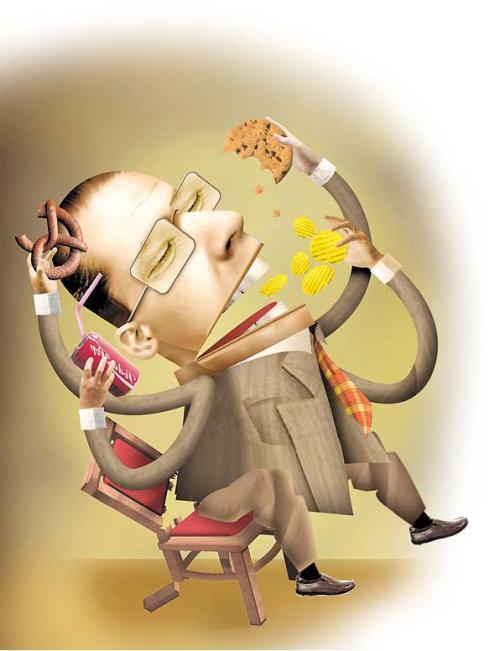Park Ju-yong, 20, is always conscious of what he eats. He is constantly on a diet, trying to minimize and moderate the foods he eats.
Whenever the stress of suppressing his appetite becomes unbearable, he buys loads of food ― bread, butter, instant noodles, pizza, donuts, fried chicken and so forth ― and starts binge eating.
But the pleasure of eating does not last long. After feeling a severe sense of guilt, he takes laxatives that will sweep away what he has eaten.
“I don’t know what I am doing. My self-esteem falls to its lowest point and I feel terrible. The unfettered craving to control weight, followed by the irresistible impulse to eat always drives me crazy,” he confessed.
Park is not the only one.
According to the National Health Insurance Corp., the number of patients treated for bulimia rose to 2,246 in 2011 from 1,802 in 2008.
Whenever the stress of suppressing his appetite becomes unbearable, he buys loads of food ― bread, butter, instant noodles, pizza, donuts, fried chicken and so forth ― and starts binge eating.
But the pleasure of eating does not last long. After feeling a severe sense of guilt, he takes laxatives that will sweep away what he has eaten.
“I don’t know what I am doing. My self-esteem falls to its lowest point and I feel terrible. The unfettered craving to control weight, followed by the irresistible impulse to eat always drives me crazy,” he confessed.
Park is not the only one.
According to the National Health Insurance Corp., the number of patients treated for bulimia rose to 2,246 in 2011 from 1,802 in 2008.

The Mayo Clinic defines bulimia as a serious, potentially life-threatening eating disorder. People with bulimia may secretly binge ― eating large amounts of food ― and then purge, trying to get rid of the extra calories in an unhealthy way, it says. For example, a person with bulimia may force vomiting or perform excessive exercise, purging even after eating only a small snack or a normal-size meal.
Professor Lee Sun-koo of Ilsan Hospital explains that those with bulimia are mostly preoccupied their weight and body shape, and judge themselves harshly in light of what they think are flaws.
“If the abnormal pattern of binge eating and doing something to offset the weight gain takes place more than twice a week for more than three consecutive weeks, we may call it bulimic,” Lee said.
In the NHIC report, women took up the vast majority of cases at 94.7 percent, but experts say the more notable point is the growing portion of men. The share of men suffering from the condition rose from 4.8 percent to 5.3 percent from 2007 to 2011.
Those in their 20s, regarded as the most fashion-conscious of all generations, accounted for the majority of bulimia patients among both men and women. The older people got, the fewer the cases of bulimia.
“Bulimia is believed to be related to hormonal secretion activities. But it also involves controlling compulsion or the trauma of separation anxiety in one’s childhood, too.
“The reason why women take up the majority of the bulimic patients is simple: they are more sensitive to the growing social demand for a slender figure. Most men tend to vent their stress, while most women try to get over it by eating,” Lee said. He added the increasing number of male bulimics reflects a phenomenon in which more men are making a big deal out of external features, just as women.
Bulimia is treatable. Antidepressants enhancing the serotonin system are the most effective, and counseling to correct one’s self-image should be followed, Lee said.
“We use splitting or projection treatments, too. All of these measures, when combined, can cut off the vicious circle of starving, binge eating and vomiting,” he added.
By Bae Ji-sook (baejisook@heraldcorp.com)
-
Articles by Korea Herald










![[Hello India] Hyundai Motor vows to boost 'clean mobility' in India](http://res.heraldm.com/phpwas/restmb_idxmake.php?idx=644&simg=/content/image/2024/04/25/20240425050672_0.jpg&u=)








